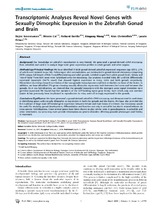| dc.contributor.author | Sreenivasan, Rajini | |
| dc.contributor.author | Cai, Minnie | |
| dc.contributor.author | Bartfai, Richard | |
| dc.contributor.author | Wang, Xingang | |
| dc.contributor.author | Orban, Laszlo | |
| dc.contributor.author | Christoffels, Alan | |
| dc.date.accessioned | 2015-09-10T20:21:06Z | |
| dc.date.available | 2015-09-10T20:21:06Z | |
| dc.date.issued | 2008 | |
| dc.identifier.citation | Sreenivasan, R., et al. (2008) Transcriptomic analyses reveal novel genes with sexually dimorphic expression in the Zebrafish gonad and brain. PLoS ONE 3(3): e1791. | en_US |
| dc.identifier.issn | 1932-6203 | |
| dc.identifier.uri | http://hdl.handle.net/10566/1596 | |
| dc.description.abstract | Our knowledge on zebrafish reproduction is very limited. We generated a gonad-derived cDNA microarray from zebrafish and used it to analyze large-scale gene expression profiles in adult gonads and other organs. We have identified 116638 gonad-derived zebrafish expressed sequence tags (ESTs), 21% of which were isolated in our lab. Following in silico normalization, we constructed a gonad-derived microarray comprising 6370 unique, full-length cDNAs from differentiating and adult gonads. Labeled targets from adult gonad, brain, kidney and ‘rest-of-body’ from both sexes were hybridized onto the microarray. Our analyses revealed 1366, 881 and 656 differentially expressed transcripts (34.7% novel) that showed highest expression in ovary, testis and both gonads respectively. Hierarchical clustering showed correlation of the two gonadal transcriptomes and their similarities to those of the brains. In addition, we have identified 276 genes showing sexually dimorphic expression both between the brains and between the gonads. By in situ hybridization, we showed that the gonadal transcripts with the strongest array signal intensities were germline-expressed. We found that five members of the GTP-binding septin gene family, from which only one member (septin 4) has previously been implicated in reproduction in mice, were all strongly expressed in the gonads. We have generated a gonad-derived zebrafish cDNA microarray and demonstrated its usefulness in identifying genes with sexually dimorphic co-expression in both the gonads and the brains. We have also provided the first evidence of large-scale differential gene expression between female and male brains of a teleost. Our microarray would be useful for studying gonad development, differentiation and function not only in zebrafish but also in related teleosts via cross-species hybridizations. Since several genes have been shown to play similar roles in gonadogenesis in zebrafish and other vertebrates, our array may even provide information on genetic disorders affecting gonadal phenotypes and fertility in mammals. | en_US |
| dc.description.sponsorship | Fellowships from Temasek Life Science Laboratory
Internal research grants from Temasek Life Science Laboratory | en_US |
| dc.language.iso | en | en_US |
| dc.publisher | Plosone | en_US |
| dc.rights | Copyright 2008 Sreenivasan et al. This is an open-access article distributed under the terms of the Creative Commons Attribution License, which permits unrestricted use, distribution, and reproduction in any medium, provided the original author and source are credited. | |
| dc.source.uri | http://dx.doi.org/10.1371/journal.pone.0001791 | |
| dc.subject | Zebrafish | en_US |
| dc.subject | Reproduction | en_US |
| dc.subject | Adult gonad | en_US |
| dc.subject | Testis | en_US |
| dc.subject | Cross-species hybridizations | en_US |
| dc.subject | Ovaries | |
| dc.subject | Gene expression | |
| dc.subject | Microarrays | |
| dc.subject | Cloning | |
| dc.title | Transcriptomic analysis reveal novel genes with sexually dimorphic expression in the zebrafish gonad and brain | en_US |
| dc.type | Article | en_US |
| dc.privacy.showsubmitter | false | |
| dc.status.ispeerreviewed | true | |
| dc.description.accreditation | Web of Science | en_US |

